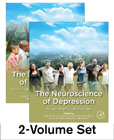
The Neuroscience of Depression
Martin, Colin R.
Hunter, Lan-Anh
Patel, Vinood B.
Preedy, Victor R.
Rajendram, Rajkumar
The Neuroscience of Depression: Genetics, Cell Biology, Neurology, Behaviour and Diet is a comprehensive reference to the aspects, features and effects of depression. This book provides readers with the behavior and psychopathological effects of depression, linking anxiety, anger and PSTD to depression. Readers are provided with a detailed outline of the genetic aspects of depression including synaptic genes and the genome-wide association studies (GWAS) of depression, followed by a thorough analysis of the neurological and imaging techniques used to study depression. This book also includes three full sections on the various effects of depression, including diet, nutrition and molecular and cellular effects. The Neuroscience of Depression: Genetics, Cell Biology, Neurology, Behaviour and Diet is the only resource for researchers and practitioners studying depression. The Neuroscience of Depression: Features, Diagnosis and Treatment Covers a pharmacological and behavioral treatment optionsFeatures sections on diagnosis and biomarkers of depressionDiscusses depression in children, teens and adultsContains information on comorbidity of physical and mental conditionsIncludes more than 250 illustrations and tables The Neuroscience of Depression: Genetics, Cell Biology, Neurology, Behaviour and Diet Features a section on neurological and imaging, including SPECT NeuroimagingAnalyzes how diet and nutrition effect depressionExamines the molecular and cellular effects of depressionCovers genetics of depressionIncludes more than 250 illustrations and tables INDICE: I. Genetic Aspects of Depression 1. Epigenetics in depression 2. Genes, depression and nuclear DNA 3. Molecular aspects of postpartum depression 4. Genetics and epigenetics of the SLC6A4 gene in depression 5. Tryptophan related genes and depression 6. Metalloproteinases genes and depression 7. Linking gene regions jointly with environment and depression II. Molecular and Cellular Effects of Depression 8. Linking depression, mRNA translation and serotonin 9. Changes in cortical gene expression in major depression: More evidence implicating inflammatory-related pathways in disease aetiology 10. FKBP5 gene expression and depression 11. Cytokines related to depression 12. Linking Interleukin-6 and Depression 13. The role of inflammatory signaling in comorbid depression and epilepsy 14. Brain inflammasomes in depression 15. Inflammatory factors and depression in substance use disorder Francisco 16. Linking Huntington disease, brain-derived neurotrophic factor and depressive-like behaviors 17. Depression and the NMDA receptor/NO/cGMP pathway 18. Translocator protein (18 kDa TSPO) binding in depression 19. Axonal transport proteins: what they are and how they relate to depressive behaviours 20. Molecular features of adenylyl cyclase isoforms and cAMP signaling: a link between adenylyl cyclase 7 and depression 21. Neurobiology of depression: the role of glycogen synthase kinase 3 22. Sortilin/NTSR3 in depression 23. Wnt/beta-catenin signaling pathway and antidepressant role 24. The prefrontal cortex in depression: use of proteomics III. Neurological and Imaging Features 25. SPECT Neuroimaging and depression 26. Resting-state functional magnetic resonance imaging (MRI), bipolar depression and unipolar depression 27. Linking amygdala blood oxygenation-level-dependent (BOLD) activity and frontal EEG in depression 28. The rostromedial tegmental nucleus: features and links with alcohol and depression 29. Serotonergic neurons, selective serotonin reuptake inhibitor (SSRI) resistance and major depressive disorder 30. Role of nesfatin-1 in major depression 31. Impact of NGF signaling in neuroplasticity during depression: Insights in neuroplasticity dependent therapeutic approaches 32. Depression and germ cells memory IV. Behaviour and Psychopathological Effects 33. Cognitive function and neurocognitive deficits in depression 34. Cognitive and interpersonal contributors to relationship distress and depression 35. Adolescence life stage and cognitive vulnerability to depression 36. Determining the cognitive performance in first episode of depression 37. Body image and depression 38. Sleep, anxiety and depression 39. Depression, anxiety and quality of life 40. Reward Processing and Depression: Current Findings and Future Directions 41. Sexual functioning in depressive disorders V. Diet, Nutrition and Botanicals 42. Linking dietary glycemic index and depression 43. Gut microbiota and Depression 44. Linking dietary methyl donors, maternal separation and depression 45. Convolvulus pluricaulis usage and depression 46. Antidepressant effects of Crocus sativus (saffron) and its constituents 47. Mechanisms of action of herbal antidepressants 48. Depression, antidepressant-like effects and mechanisms of the herbal formula xiaochaihutang VI. Resources 49. Resources in depression
- ISBN: 978-0-12-818009-9
- Editorial: Academic Press
- Encuadernacion: Rústica
- Páginas: 1000
- Fecha Publicación: 01/03/2021
- Nº Volúmenes: 1
- Idioma: Inglés
